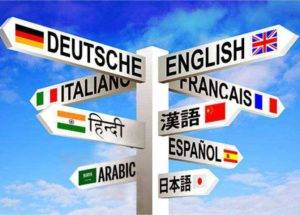What Is The Relationship Between Language And Culture?

Paralanguage is the non-lexical component of speech specific to every culture. It is a very broad concept that includes such things as body language and ton or pitch of your voice.
Paralanguage is different depending on where you grew up. There are certain gestures, expressions, or intonations that we learn from people surrounding us. Body language in one country that conveys hostility may be seen as welcoming in another country. This is why paralanguage may cause misunderstandings during the communication of various ethnic groups.
Because paralanguage includes pitch, intonation, speed of speaking, facial expressions, gestures, and hesitation noises, it greatly influences the language you are speaking. If you are bilingual, you might have noticed the way your voice “changes” when you speak different languages. You might also see that your gestures or even habits change when you do so.
Homologous Relationship
There is a prominent homologous relationship between language and culture. They appeared and developed together long before people were able to write or be aware of themselves.
“The phrase “language is culture and culture is language” is very meaningful. There are not only various interconnections between the two but a lot of history. Language and culture developed together, influencing the lives of people just as much as one another. In order to understand one, you must understand the other,” explains Elisa Abbott, a writer, and translator for PickWriters.
When we look back at the history of language and culture, there are certain parallels here and there. The evolution of language directly influenced the development of culture and vice versa. The more advanced our language was, the more cultured we were.
Influencing The Thinking Process
According to linguistic relativity, the way we see the world is largely influenced by the language we use to discuss it. So, if you speak and think in German, then you will have a different perception of your environment and the world than someone who speaks and thinks in Chinese.
Some people who are bilingual and use two languages or more on a daily basis may have thoughts in both of those languages. This may result in them having different views on the world and maybe even a better understanding of it from various sides.
Similarly to the language, the culture that you grew up influences the way you perceive your surroundings. You will have not only different values or morals but also a different mindset and logic.
Inter-Cultural Interactions
Nowadays, it is very common for various cultures to interact with. Travel is a lot more accessible than it used to be and a lot of people even choose to move to a different country and spend their life in a culture originally foreign to them. How does this relate to language?
Well, for starters, some languages may have concepts that are absent in other languages. Such situations are also influenced by the culture that is related to the specific language. Obviously, when two people from two separate cultures try to converse, they may experience miscommunication.
Another issue is the behavioral habits that a person develops when growing up in a certain culture. As mentioned before, the body language is quite varying around the globe, and there are differences that may influence the inter-cultural interactions between people.
Transmission
Language is primarily learned through oral communication rather than written. Children grasp the basic concepts of structure and grammar before they even go to school. Their primary sources at this age are parents. Once they go to pre-school, kids are taught the basics of their first language. But when they go to school, they are taught more complicated structures and concepts about their first or second language. However, the foundation is still laid out even before school.
Similarly to language, culture is sort of inherited from the child’s surroundings. Not only is the family responsible for it, but also the country with its customs, traditions, and citizens. The child absorbs the information he or she sees and hears, even on an unconscious level.
Once the child has grown up a little, another source of cultural and linguistic learning is the written one. Depending on what books and in which language the child reads, his or her mindset will be corresponding. Bilingual people often recall learning both languages not only due to the fact that they used them in their daily lives but also because they processed the information they got from written materials. These are also considered a powerful tool in learning a language, right after the oral speech.
Assimilation And Social Interactions
Before so many languages were present on our planet, there were several main primary languages spoken by large groups of people. With time the people evolved as well as their cultures and the language they spoke. This is usually attributed to the fact that they felt they needed to adapt to new circumstances and assimilate.
Various dialects have also developed because of the influences certain cultures had on others. One of the oldest examples of this can be that of Ancient Greece and Rome. When the Romans captured Greece, they were greatly influenced by Greek culture, language, and most importantly – religion. The Romans had adopted the Greek pantheon of gods and with this some of their culture. Another example is that of France and England when the Englishmen started speaking French and the English language (which was then much more similar to German) adopted a huge part of vocabulary from French. Nowadays, English has approximately 30% of words originating from French.
One of the reasons why certain tribes I changed their language was because they wanted to be better than others. In other cases, they needed to be accepted on new land, so one of the obvious steps was to adopt the customs and traditions of the locals.
Diversity
The linguistic varieties of a language can be categorized into geographical, social, and functional. Geographical differences happen when a form of the language is used in certain parts of a community. For example, the language spoken in the Eastern part of a country may differ from the one spoken in the West. Social differences are influenced by gender, age, and occupation. For example, a professor will talk differently from a politician or an office worker. Functional differences stem from the function and situation that the language is used in.
But regardless of these dissimilarities, culture unifies people speaking variations of one language or even speaking several languages. This is also true for a language unifying people from varying cultural backgrounds.
Conclusion
To sum up, language and culture are definitely an integral part of our life. There are many differences we share due to our different identities and individualities, but there also many similarities that we have thanks to the connections between our cultures and languages we speak.

Kristin Savage
Author
Bio:
Kristin Savage nourishes, sparks and empowers using the magic of a word. Along with pursuing her degree in Creative Writing, Kristin was gaining experience in the publishing industry, with expertise in marketing strategy for publishers and authors at StudyClerk. You can find her on Facebook.














